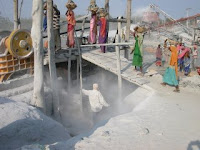
It's our first day in India and we met
Dr. TK Joshi in Delhi who invited us to the
Center for Occupational and Environmental Health (COEH) at GB Pant Hospital near Connaught Place in the center of Delhi. This is a government agency which focuses on occupational health issues and is staffed by occupational health physicians. We met him and his associates, including
Dr. Neeraj Gupta, and learned about the challenges India faces in occupational health education.
We were able to spend a significant amount of time with the doctors and were able to ask all sorts of questions. I felt I should have been more prepared but I have been studying this subject for quite a few years and sometimes there are just too many things to ask. I just wanted them to speak freely and after we spoke in detail about our intentions they came alive. I wanted to know what they felt were the immediate needs of the medical community and the challenges they faced as occupational health professionals.
In 1992 the Supreme court ruled that in Delhi workers must be kept safe "by any means possible," and unlike some other states, Delhi regulated it's industries well. This caused most stone crushing industries to move 70 km outside the city, to the state of Haryana. The
1948 Factories Act does require industries in India to follow guidelines to keep their workers safe but it is up to the state to enforce these rules. Dr. Joshi plans to open a clinic in Badapur soon. It seems wherever industry faces regulation that makes work more expensive, they seem to find somewhere else to go. This reinforces my feeling that education of the workforce is the answer to these problems.
It also reminded me of some previous recommendations that I received back home in San Francisco. Christa Robertson RN, a friend of mine and a member our Medical Advisory Board gave me a recommendation based on the success she had experienced in public health education. When she read my initial proposal back in July she mentioned giving workers a short quiz before educational programs and giving them the same quiz after to measure our success. I was very happy to hear that Dr. Joshi and Dr. Gupta had been doing this sort of thing and wanted to continue doing so. They said there was a need for these quizes to be catered for every industry, I agreed. I expressed the need for these types of measurements to give funders an idea of how successful our programs were and they seemed to agree. I want to fund projects they carry out with oversight, but I want them to understand that I trust them.
I told them of my disappointment with the way litigation had been a burden on workers in the United States who had been made sick from asbestos exposure. They agreed that the purpose of our projects should focus on the persuasion of employers not prosecution. Unfortunately, they do not get enough support from the labor department. It is difficult for them to enter places of work. They find it frustrating that only one occupational health professional is nominated to the labor department and the rest of the nominees are engineers. This professional is only answerable to the labor department. The labor department does not do field activities or implement the law. They mostly work with big reputable multinational institutions.
I was extremely encouraged that both doctors are primarily interested in working with the unorganized sector. These are small employers who have run cottage industries and rarely pay attention to laws and regulations. Most of these workers are illiterate and very poor. They are the ones who would benefit most from educational programs aimed at workers.
Dr. Gupta kept saying, "You are answerable to your own self, at the end of the day you want to contribute to something good."
He cautioned us to look at individuals and evaluate them based on their goals.
"Every individual has his own initiatives," he said.
They spoke of the power of pamphlets and brochures and hope some day to make a documentary that is in English, Hindi, and local language. This would help with education and awareness. They agreed that smoking cessation was extremely important.















